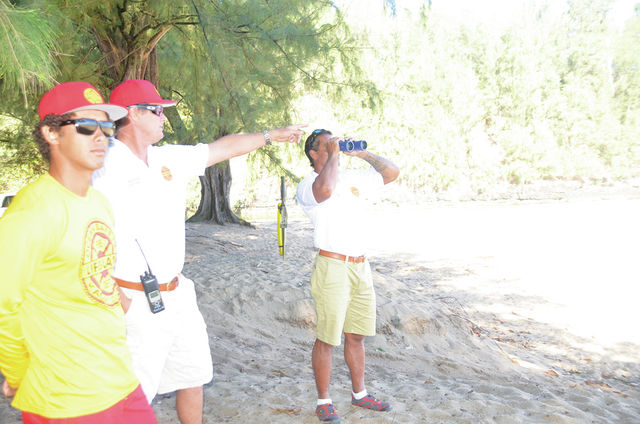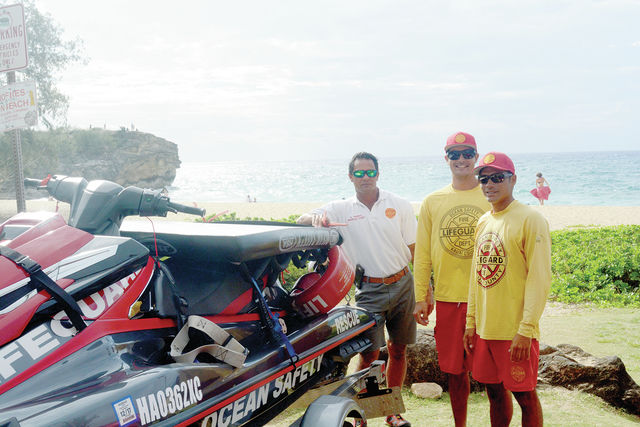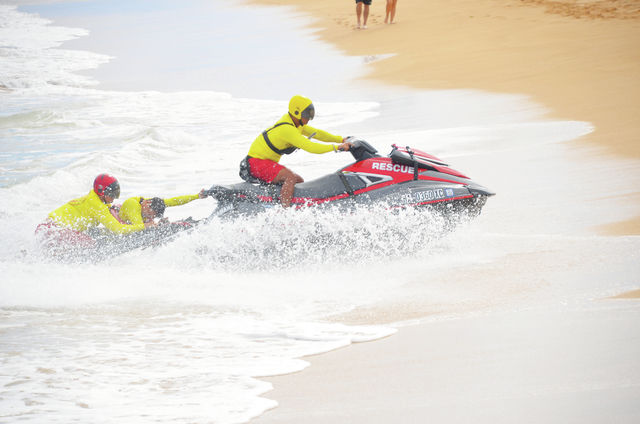LIHUE — From educating beachgoers about conditions to responding to swimmers in distress, Kauai’s roving patrol unit is protecting the island’s unguarded beaches. “Tourists find the hidden gems, but there’s no lifeguards to warn them of the dangers,” said Kleve
LIHUE — From educating beachgoers about conditions to responding to swimmers in distress, Kauai’s roving patrol unit is protecting the island’s unguarded beaches.
“Tourists find the hidden gems, but there’s no lifeguards to warn them of the dangers,” said Kleve Zarbaugh, a lifeguard who patrols the Eastside district.
The roving patrol unit, which just rolled out in December, was made possible by donations from the Kauai Lifeguard Association in an effort to make Kauai’s beaches safer.
After raising money during the Fourth Wave Campaign concert and celebration in October, KLA raised enough money to purchase three 2016 Ram Quad Cab four-wheel-drive trucks, equipped with trailers, Jet Skis and rescue equipment, to the Ocean Safety Bureau.
The roving patrol unit is more cost-effective than installing a tower at every beach, which can cost millions of dollars, said Kalani Vierra, director of the Ocean Safety Bureau.
There are three roving patrol units — one for the North Shore, one for the Eastside and one for the South Shore/Westside — all of which are operated by two lifeguards.
On the Eastside, Zarbaugh, along with Kaeo Lopez, keeps an eye on beaches like Moloaa, Wailua and Kalapaki.
The Kapaa beaches that front Kauai Beach Resort, Coral Bay Resort, Waipouli Beach Resort, Courtyard by Marriott and the Kapaa Library are also on the list of places they patrol on a daily basis.
“A lot of the beaches aren’t guarded, especially around the hotels,” Lopez said. “There’s a high volume of tourists in those places, and we try to do a lot of prevention.”
When they aren’t patrolling individual beaches, the lifeguards like to station themselves at Anahola or Kealia because it’s the center of their district, Zarbaugh said.
“We’re finding out that’s where a lot of incidents happen,” he said.
Of all the beaches in the Eastside district, Moloaa Beach is one of the most dangerous, he said. An Idaho visitor, Michael Tremblay, drowned offshore there on Jan. 19.
‘A more elite field’
The three districts present different challenges, Vierra said.
On the North Shore, it’s big waves. On the Eastside, it’s unguarded beaches in front of hotels. On the South Shore/Westside, it’s a rocky coastline and a large number of tourists.
To qualify to work on the roving patrol, lifeguards have to be ranked as an Ocean Safety Officer 2, meaning they have at least three years of experience, Vierra said.
They also have to complete a 1,000 yard run and 1,000 yard swim under 20 minutes, and complete an 8-hour rescue craft course.
“It’s a more elite field and they are held to a higher standard,” Vierra said. “It’s a harder job, so there’s harder requirements.”
The roving units patrol their respective districts from 9 a.m. to 5 p.m. daily.
Right place, right time
The roving patrol unit has been busy already, raking in 18 rescues and five assists islandwide in its first two months.
Lifeguards assigned to the unit have also taken 3,776 preventative actions, like putting up signs and other educational measures, and helped 174 people with first aid, Vierra said.
Lifeguards estimate that since December, 83,593 people have visited Kauai’s beaches.
“Anyone who visits the beach, there’s the potential we have to save them,” Vierra said.
Roving patrol units often end up taking preventative measures simply because they were in the right place at the right time, Vierra said.
For example, Tabalno was driving by Lawai Beach a few weeks ago when he saw a swimmer in distress near a place called Acid Rock.
“We pulled up on the side of the road, pulled out our fins and tube and went out there,” he said. “From the time I saw him to the time I got to him, he was in a full panic and just his hands were above water. I told him he had to calm down because I didn’t want him to have a heart attack. We were able to bring him to shore.”
On the North Shore, Davis and Mattaniah Milbrand were patrolling Hanalei in early December when the bridge was closed due to flooding.
“A couple had left their car and were attempting to cross on foot, but there was a lot of debris in the water,” Davis said. “We got them out of the street, and right then, a big tree floated by. It would’ve taken them out.”
Setting a game plan
While the lifeguards have an idea of where they’ll patrol, plans can change depending on the day’s conditions, Vierra said.
“They collaborate with their supervisor, but we leave it up to them,” he said.
Makana Weiss, who patrols the North Shore, said every day is a little different.
“We may stay at some places a little longer, depending on the crowd,” he said. “If the turnover rate is high, and people aren’t being safe, we’ll stay there a little longer.”
The North Shore unit patrols beaches from Kee to Moloaa. Hot spots include Anini and Lumahai beaches, both of which have strong waves and currents.
“A lot of people get into trouble at Anini; it’s a big advertised spot for snorkeling,” said Kawai Davis, who also works with the North Shore unit. “Even when we didn’t have the patrol, we were responding there a lot.”
On the South Shore, the roving patrol unit stops at Lawai and Shipwrecks beaches and Kukuiula Harbor.
The lifeguards drive by Lawai Beach at least five or six times a day to keep an eye on things.
“There’s a lot of tourists and the currents are strong,” said Alohi Costa, who operates the patrol unit.
Because so many tourists stay in Poipu and Koloa, the roving patrol focuses mainly on that area. But if there are high surf advisories and other adverse weather conditions, they will go to the Westside to check out the Port Allen Harbor, Salt Pond, Kikiaola Harbor and Kekaha Beach, said Justin Tabalno, the other unit operator.
“We will keep in touch with the towers on the Westside to see if those beaches are busy and if they need backup,” he said.




